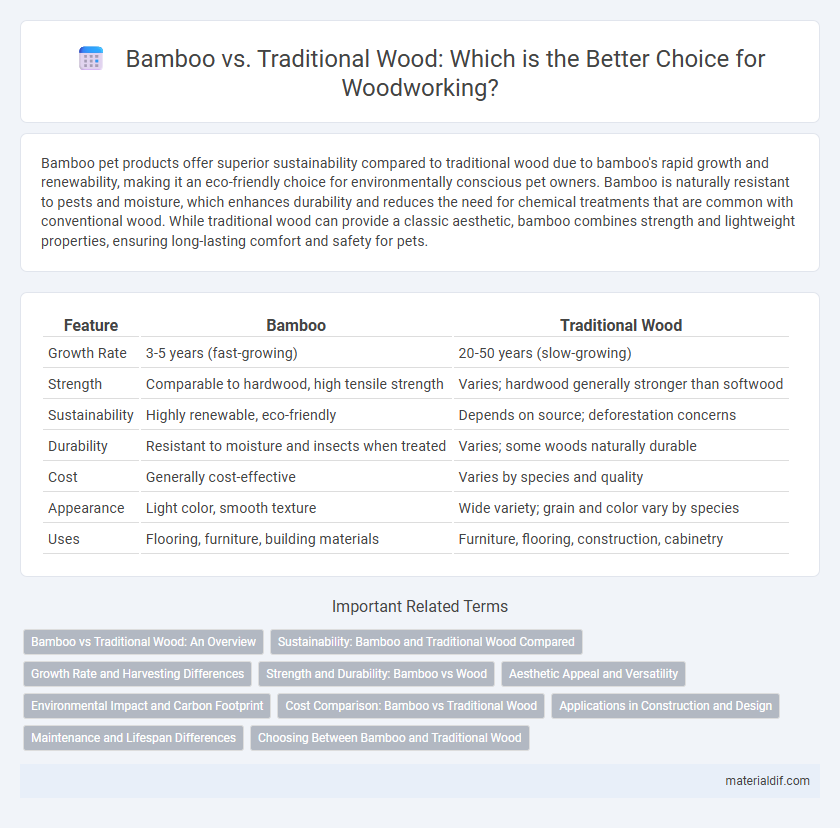Bamboo pet products offer superior sustainability compared to traditional wood due to bamboo's rapid growth and renewability, making it an eco-friendly choice for environmentally conscious pet owners. Bamboo is naturally resistant to pests and moisture, which enhances durability and reduces the need for chemical treatments that are common with conventional wood. While traditional wood can provide a classic aesthetic, bamboo combines strength and lightweight properties, ensuring long-lasting comfort and safety for pets.
Table of Comparison
| Feature | Bamboo | Traditional Wood |
|---|---|---|
| Growth Rate | 3-5 years (fast-growing) | 20-50 years (slow-growing) |
| Strength | Comparable to hardwood, high tensile strength | Varies; hardwood generally stronger than softwood |
| Sustainability | Highly renewable, eco-friendly | Depends on source; deforestation concerns |
| Durability | Resistant to moisture and insects when treated | Varies; some woods naturally durable |
| Cost | Generally cost-effective | Varies by species and quality |
| Appearance | Light color, smooth texture | Wide variety; grain and color vary by species |
| Uses | Flooring, furniture, building materials | Furniture, flooring, construction, cabinetry |
Bamboo vs Traditional Wood: An Overview
Bamboo offers faster growth rates and higher sustainability compared to traditional wood, making it an eco-friendly alternative for construction and furniture. Its tensile strength surpasses many hardwoods, providing durability while maintaining lightweight properties. Traditional wood, however, still holds advantages in terms of variety, workability, and established supply chains for diverse applications.
Sustainability: Bamboo and Traditional Wood Compared
Bamboo grows up to 3 feet per day, making it one of the fastest renewable resources compared to traditional hardwood trees, which can take decades to mature. Its fibrous structure allows for high tensile strength, rivaling that of steel, while traditional wood often requires longer harvest cycles and can contribute to deforestation if not managed sustainably. Bamboo's rapid regrowth and lower water requirements position it as a highly sustainable material compared to many traditional wood species.
Growth Rate and Harvesting Differences
Bamboo demonstrates a significantly faster growth rate, reaching maturity within 3-5 years compared to traditional hardwoods, which often take 20-50 years to mature. This rapid growth allows for more frequent harvesting cycles, making bamboo a highly renewable resource. Harvesting bamboo involves cutting stems without uprooting the plant, enabling continuous regeneration, whereas traditional wood typically requires tree felling, impacting forest ecosystems and increasing reforestation time.
Strength and Durability: Bamboo vs Wood
Bamboo exhibits remarkable strength, often surpassing traditional hardwoods like oak or maple in tensile strength, making it an excellent material for construction and furniture. Its natural fibrous structure provides high durability and resistance to wear, while traditional wood can be prone to cracking, warping, and termite damage if not properly treated. Bamboo's rapid growth and natural resilience also contribute to its sustainability and long-term performance compared to slower-growing hardwood species.
Aesthetic Appeal and Versatility
Bamboo offers a contemporary aesthetic with its smooth, uniform grain and natural golden hue, making it popular in modern interior design, while traditional wood showcases a diverse range of textures and colors, from rich mahogany to rustic oak, appealing to classic tastes. Bamboo's rapid growth and renewability enhance its versatility for flooring, furniture, and decorative panels, whereas traditional wood provides unmatched structural strength and variety for cabinetry, trim, and heavy construction. Both materials bring unique visual appeal and functional adaptability, allowing designers to choose based on style preference and project requirements.
Environmental Impact and Carbon Footprint
Bamboo grows rapidly, reaching maturity in 3-5 years, making it a highly renewable resource compared to traditional hardwoods, which can take decades to mature. Bamboo's dense root system minimizes soil erosion and promotes carbon sequestration, resulting in a lower carbon footprint throughout its cultivation and harvesting process. In contrast, traditional wood harvesting often contributes to deforestation and higher carbon emissions due to slower growth rates and more intensive processing requirements.
Cost Comparison: Bamboo vs Traditional Wood
Bamboo offers a cost-effective alternative to traditional wood, with prices typically 20-40% lower due to its rapid growth and sustainable harvesting methods. Traditional hardwoods such as oak or maple often incur higher costs due to slower growth rates and more intensive processing requirements. Bamboo's affordability combined with its durability makes it a popular choice for flooring and furniture, providing significant savings without compromising quality.
Applications in Construction and Design
Bamboo offers superior tensile strength and rapid renewability compared to traditional wood, making it ideal for sustainable construction and eco-friendly design projects. Its lightweight nature and flexibility allow for innovative architectural forms and earthquake-resistant structures that traditional hardwoods cannot easily achieve. Bamboo also absorbs carbon dioxide efficiently, enhancing the environmental impact of buildings, especially in modern green construction initiatives.
Maintenance and Lifespan Differences
Bamboo requires less maintenance than traditional wood due to its natural resistance to moisture, insects, and decay, making it ideal for outdoor applications. Traditional wood often demands regular sealing, staining, or painting to prevent rot and deterioration, which increases upkeep costs and labor. Bamboo's lifespan rivals or surpasses that of traditional hardwoods, lasting up to 25-50 years when properly maintained, while untreated traditional wood typically lasts 10-20 years.
Choosing Between Bamboo and Traditional Wood
Bamboo offers exceptional sustainability due to its rapid growth rate, making it an eco-friendly alternative to traditional hardwoods like oak or maple. Traditional wood provides greater density and durability, often preferred for heavy-duty furniture and flooring requiring long-term resilience. Choosing between bamboo and traditional wood depends on priorities such as environmental impact, strength requirements, and aesthetic preferences.
Bamboo vs Traditional Wood Infographic

 materialdif.com
materialdif.com